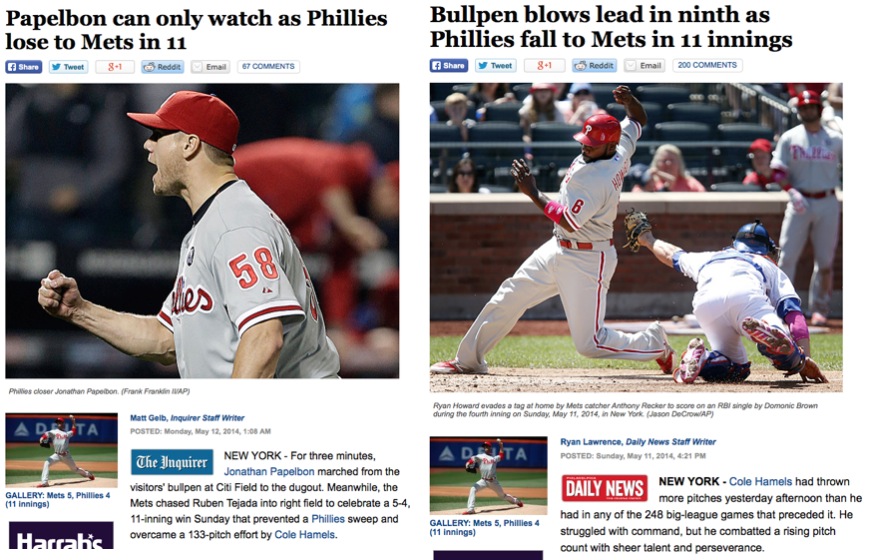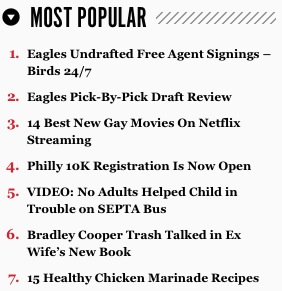Ad Disclosure
A Proposed Solution for Saving the Inquirer, Daily News and Philly.com
By Kyle Scott
Published:
Our old friend John Miller – previously the head honcho at Philly Sports Daily, an Eagles post-game host on WIP, and a PR exec – has proposed a solution for saving the Inquirer, Daily News and Philly.com. The idea? Instead of three brands, create separate, niche publications:
Unbundle the sections of the paper.
Rather than have three separate (and yet somehow overlapping) entities all delivering a slightly different version of all these types of news, why not align your offering based upon the vertical columns? That’s how people consume the news, so why not deliver it that way? The argument against that is that all those people who devour sports will never accidentally stumble across the real news about City Hall and the school district, and therefore not be adequately educated about the world around them. Well, guess what? We’re already there. Again, this is how people already consume the news.
In marketing terms, the Philadelphia newspapers should transform from a branded house (really, three branded houses) to a house of brands. Procter and Gamble is the best known house of brands; you’ve heard of P&G but their brands are what stand out – Pampers, Duracell, Gillette, and on and on.
Likewise, the newspapers should build up their specific vertical news offerings into distinct brands – Sports, Business, Food, Local News, Education, etc. By doing so, they enable themselves to meet the audience where it’s at, and also to dive deeper and deeper to create a better offering. The rise of long form and explanatory journalism shows that there is a segment of the audience that is willing to dive deeper and deeper into a variety of topics. Therefore, rather than writing sports news for non-sports fans in an effort to get them to read that section of the paper, the sports department can dive deeper and deeper. And if you can’t “win” in a specific topic – national political coverage for instance – don’t do it. The local papers tried to do this a couple years ago when they introduced a sports-only app, but it was poorly executed and faded away (note: Execution matters).
Not a bad idea. I half agree with him.
It makes no sense that the Inquirer, Daily News and Philly.com have separate staffs and often overlapping coverage. Why not, like John wrote, take each vertical and combine the efforts of the many talented people from the Inquirer and Daily News, and the few talented people who work exclusively for Philly.com, all of whom get their paychecks from the same company? Why have Matt Gelb and Ryan Lawrence write a recap about the same game? Have one write the recap and the other do something more analytical. The Daily News is already sort of doing this by having David Murphy serve as their hybrid baseball reporter-columnist-douchebag.
The problem with John’s idea, however, is that creating separate brands for sports, news, etc. would prove difficult. The Inquirer and Daily News have had a hard enough time getting people to visit their separate URLs. It would be damn near impossible to get readers to type in different addresses for different sections. But there’s no reason a brand can’t be created around each section or even team. Just look no further than what Philly Mag did with Tim McManus and Sheil Kapadia’s Birds 24/7, which routinely generates the most-viewed articles on their website:
This sort of thing is easy enough to do online – creating deeper, more focused niche sections with their own brand identities – but what about in print? You can’t sell a sports only paper (the Daily News tried that with SportsWeek and it was a disaster… except the time they wrote about me, of course), and you certainly can’t sell a news- or politics-only paper. And once you start combining category reporters, what’s to differentiate the Inquirer and Daily News? Well, nothing. Just get rid of the Daily News as a product and combine the aforementioned efforts into one mega publication available both online, at Philly.com, and in print, in the Inquirer. Now you instantly have a quality paper for those who still insist on staining their hands with ink. You have a quality website that doesn’t look like the disfigured child of the Huffington Post and BuzzFeed. And, most importantly, you have a good product that people might be interested in paying for.
Kyle Scott is the founder and editor of CrossingBroad.com. He has written for CBS Philly and Philly Voice, and been a panelist or contributor on NBC Sports Philly, FOX 29 and SNY TV, as well as a recurring guest on 97.5 The Fanatic, 94 WIP, 106.7 The Fan and other stations. He has more than 10 years experience running digital media properties and in online advertising and marketing.

